In-Depth
Microsoft Throws Hardware Roadmap for Loop with Windows 10 as a Service
Will free upgrades uncouple Windows releases from the PC refresh cycle?
- By Scott Bekker
- March 11, 2015
For decades a new Microsoft Windows release went hand-in-hand with new PC releases. The desktop, and later laptop, portable and ultraportable, release cycle was driven to a large extent by the Windows ship schedule.
Windows 8 broke that cycle. The OS went out the door and into the teeth of a historic storm of declining PC sales. Windows 8 didn't reverse that decline or drive the usual spike in shipments. Whether its radical touch-first interface, which took some getting used to, contributed to the problem or whether the many factors outside of the Windows 8 purview were more important is up for debate.
Now, Microsoft has decided to make Windows 10 upgrades free for Windows 7, Windows 8 and Windows 8.1 (excluding Enterprise Editions), and to allow those who upgrade to Windows 10 to continue to upgrade to the latest OS for free for the life of a device. Will that decision forever decouple Windows refreshes from hardware release cycles?
The picture is cloudy in the near term. Windows 10 is expected in the second half of 2015, and different bands of Windows users represent very different selling opportunities this year:
Windows 8: The early adopters who jumped on Windows 8 or Windows 8.1 account for about 19 percent of global users (all user statistics come from StatCounter results as of the end of January). While some of these users are among those most likely to buy new systems to keep current with the latest features, this is also the group most likely to be able to upgrade to Windows 10 for free and continue to get life out of a system for the longest with the continuous upgrade model. The new Windows-as-a-Service model could depress early adopter purchases among current Windows 8 users. However, the fact that a Windows 8.1 system purchased now isn't going to be obsolete in six months could encourage more buying throughout the year.
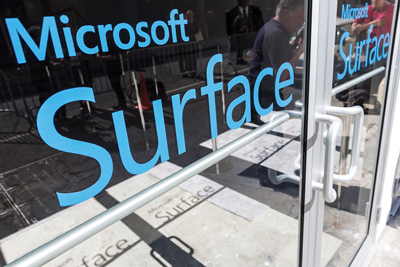 In the future, expect news of major hardware innovations on Windows systems to come in dribs and drabs at individual manufacturers' press events.
In the future, expect news of major hardware innovations on Windows systems to come in dribs and drabs at individual manufacturers' press events.
Source: Surface Pro 3 launch event, May 2014
Windows 7: By far the biggest group of users have Windows 7. With 55 percent of all PC users on the versatile and business-friendly version, this is a huge potential market for Windows 10. Many of the systems are aging, as Windows 7 became generally available in October 2009. Users generally stuck with Windows 7 through the Windows 8 release cycle as they dedicated their compute budgets to tablets and smartphones. With Windows 10, Microsoft is no longer forcing users to touch their screens to get things done the way they had to with Windows 8, making it a more seamless upgrade for those interested in trying the new OS on Windows 7 hardware. The Windows 7 upgrade community could go either way -- some buying new systems for Windows 10, others using the free upgrade to Windows 10 on more recent Windows 7 PCs. Windows 7 has a long time until extended support ends in January 2020. A good chunk of Windows 7 users won't be migrating for years.
Windows XP & Windows Vista: Support ended a year ago for Windows XP (in use on 12 percent of PCs) and ends for Windows Vista (less than 3 percent of PCs) in April 2017. The more traditional aspects of the Windows 10 computing experience could be attractive to both of these groups of late adopting users, but both are relatively small market opportunities.
2-in-1 Enthusiasts: Full-powered PCs with screens that detach to become tablets are growing in popularity. The Continuum interface in Windows 10 aims to make the process of switching between usage modes much more seamless and natural. The Microsoft Surface is only one example. Intel recently said that there were 70 2-in-1 designs available. Windows 10 could be a driver for this segment.
Bargain Systems: The prices on Windows PCs have come down rapidly with many choices in the $200 to $300 range for desktops and laptops. At those prices, systems are starting to get to the point where paying for the OS or not isn't as much of a factor. The free upgrade aspect of Windows 10 may not impact this sector much, although it should give users pause about buying PCs with cut-rate amounts of storage. No amount of free cloud storage will help if you need 16GB of free drive space to upgrade to the next OS.
Corporate Purchasers: A big question mark hovers over how business purchases will proceed in the future. Pro editions of Windows 7, 8 and 8.1 are included in the free upgrade offer, but Enterprise Editions are not. Will Microsoft be successful in upselling on the manageability features and the ability to beg off on feature updates in a way that's more consistent with traditional IT approaches? In any event, the business purchase cycle tended to lag the Windows release cycle by six to 18 months.
Longer term, disentangling OS releases from a fixed hardware cycle must result in a new equilibrium for the PC industry. Apple Inc. has been able to drive big hardware sales in tandem with new OS releases by controlling both sides of the product. Microsoft has a few hardware products (Surface, Lumia), but shows little potential for working its way into a similar position. Instead, Microsoft is reliant on OEMs, and without big OS milestones to focus and organize them, it will be like herding cats to get them to embrace new hardware-dependent features. Think of the Google Android ecosystem with its mix of benefits and challenges.
What that means for now is existing PC shows, such as the Computer Electronics Show (CES), could become even more important than they already are, as purchasers -- corporate and consumer -- will feel freer to make decisions in the moment based on the best available systems.
That CES 2015 Lineup Becomes More Significant
The most recent CES in Las Vegas in early January was the debut for dozens of new portable PCs for business customers that were available immediately or later in the first half of 2015. At the time, they were billed as Windows 8.1 systems, but given the free upgrade to Windows 10 that Microsoft announced later that same month, they effectively became Windows 10 (and 11 and 12) systems, as well.
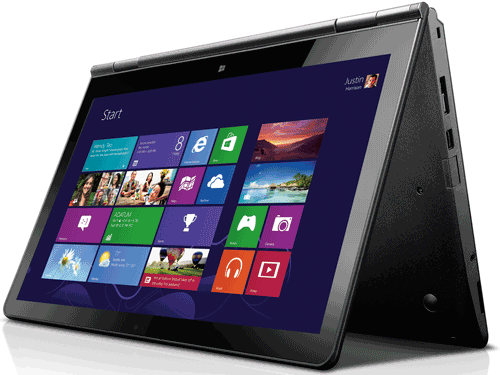 Lenovo ThinkPad Yoga 15
Lenovo ThinkPad Yoga 15
At CES, Lenovo unveiled the ThinkPad Yoga 15-inch convertible. Like other systems in the Yoga line, it includes four modes -- laptop, stand, tent and tablet. Unlike them it comes in a new larger size with an optional 3-D camera. It was pitched at CES as a Windows 8.1 device. The Windows 10 pricing announcements mean Yoga 15s bought now will run Windows 10 later. The Continuum UI of Windows 10 should make the transition among modes smoother, as well.
Source: Lenovo
Some of the vendors tried to appeal to potential Apple MacBook customers, others focused on raw business utility, while still others emphasized flexible-hinged approaches that exploit the multiple personalities of the Windows 8.1 OS. Across top-of-the-line offerings, though, vendors are incorporating the newly released Intel Corp. processor generation known by its code name "Broadwell." For right now, it's Intel among all the chipmakers that most seems to be driving the PC industry.
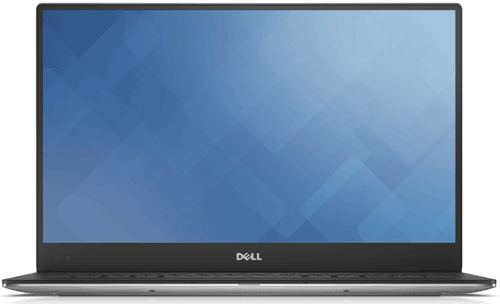 Dell XPS 13
Dell XPS 13
Intel processor advancements are helping drive innovation in the Windows ecosystem, such as this Dell XPS 13 introduced at CES. Intended as a challenge to the Apple MacBook Pro, prices start at $800 for the system powered by 5th Generation Intel Core processors. Dell Inc. markets the laptop as having a "borderless infinity display," which makes the screen appear larger while giving the device the feel of an 11-inch laptop. Dell also claims a 15-hour battery life.
Source: Dell Inc.
Formally, Intel refers to Broadwell now as 5th Generation Intel Core processors. One example of a manufacturer going all-in with the Broadwell focus is Acer, which fits its Aspire R 13 Series, its Aspire S7 Ultrabook line and even its Acer Aspire Switch 12 with Broadwell family chips.
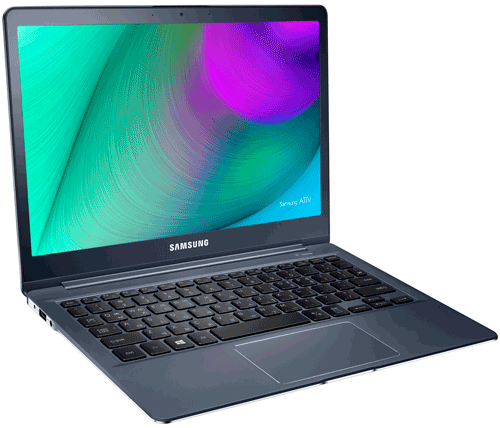 Samsung ATIV Book 9
Samsung ATIV Book 9
Security was the focus of hardware innovation for a new Samsung laptop that will ship later this year. The Samsung ATIV Book 9 gives users the ability to set a drawing pattern on the touchpad at login and includes a single-function command (Fn10) for selecting a window to hide in order to protect private information in a public setting. The Intel Broadwell Core M processor-based system boasts 10.5-hour battery life, 0.46-inch thickness and a weight of just over 2 pounds.
Source: Samsung
Other systems built around Broadwell internals include the Dell XPS 13, the Samsung ATIV Book 9, the HP Zbook 14 and 15u, and the Lenovo ThinkPad Yoga and ThinkPad X1 Carbon, among many others.
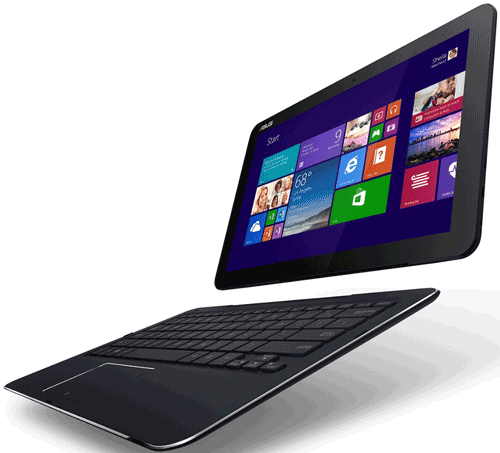 2-in-1 Power
2-in-1 Power
Two-in-ones shown at CES, such as this ASUS Transformer Book T300 Chi, took on a new significance with the later news that upgrading them to Windows 10 would be free, and they would benefit from the Microsoft Continuum UI.
Source: ASUS
At a high level, Broadwell is an overdue "Tick" in the "Tick-Tock" processor delivery model Intel has been trying to adhere to since 2007. Every year to 18 months, Intel aims to either shrink the process technology, a tick, or develop a new microarchitecture on the resized die, a tock. Intel is talking less about ticks and tocks, and also revealing less about its roadmap, these days. In business PCs, however, the model applies through at least the end of 2015.
Broadwell takes the "Haswell" architecture tock, also known as 4th Generation Intel Core Processors, and refits it from its original 22nm size to a smaller 14nm die. Compared to the 4th Generation chips, Intel says Broadwell has 35 percent more transistors on a 37 percent smaller die. As for performance improvements, Intel says going from 4th generation to 5th generation improves graphics performance by 24 percent, video conversion speed by 50 percent and battery life by 1.5 hours. Core business productivity tasks, such as Microsoft Word, don't get a noticeable speed improvement.
Obviously aware that one of the biggest problems the PC industry has is the ever-slowing refresh cycle, Intel touted the prowess of Broadwell there in a recent fact sheet: "Consumers who are planning to refresh a 4-to-5-year-old PC will also notice significant improvements: graphics performance up to 12 times better, video conversion speed up to 8 times faster, productivity performance up to 2.5 times faster, wake times 9 times faster, all with up to 2 times longer battery life."
The timing of Broadwell was good for portables and ultraportables at CES, but it had been expected months earlier, possibly in time for the 2014 holiday season. Intel has been relatively mum on when or whether a desktop version of Broadwell might ship, and a tablet/system-on-a-chip version code-named "Cherry Trail" has only begun shipping to device manufacturers. Expect to see designs based on Cherry Trail later this year.
While Broadwell got good uptake in CES systems, it may be a relatively short-lived platform, even for Intel. Broadwell was late, but its successor 6th Generation "Skylake" could be comparatively early. Skylake would set a microarchitecture for the 14nm process that would also work with the next-generation 10nm process. Intel has said Skylake systems will debut in the second half of the year, right around the time Windows 10 is expected to ship. A caution: Intel provided that shipping guidance before Microsoft publicly dropped the free upgrade bombshell.
In the end, the 2015 CES may have served as an apt preview of the new Windows future. Windows hardware innovations will likely be spread throughout the year at big industry events like CES, at OEM individual launch events, at Microsoft Surface launches and at Intel events. And those announcements will need to be reinterpreted months later based on new software feature updates that Microsoft drops into the code on an ongoing basis. Hardware advancements will be heralded in a way that's less reminiscent of the stately press releases of the early 2000s when various industry CEOs weighed in on each other's announcements with considered supporting quotations. The new model will be more like the incessant scroll of a Twitter feed.